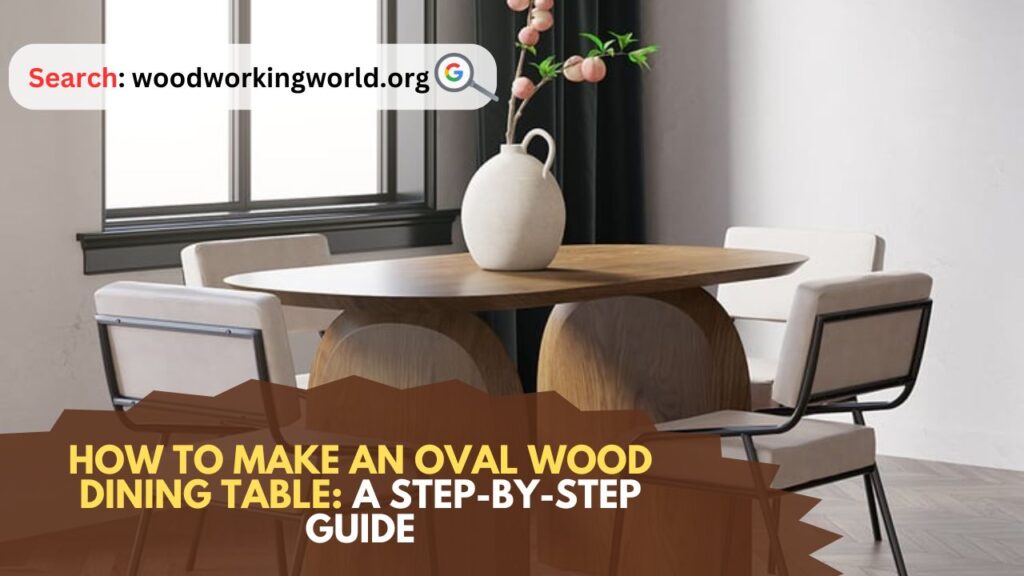Oval Wood Dining Table: Creating a custom oval wood dining table can be a rewarding woodworking project that results in a beautiful and functional piece of furniture for your home. This guide will take you through the process step-by-step, from selecting the right materials to finishing the table. Whether you’re an experienced woodworker or a beginner looking to challenge yourself, this project can be accomplished with patience and attention to detail.

How to Make an Oval Wood Dining Table
Materials and Tools You’ll Need to Make an Oval Wood Dining Table
Materials:
- Hardwood boards (oak, maple, walnut, etc.) for the tabletop.
- Hardwood or softwood for the table legs and apron.
- Wood glue.
- Wood screws.
- Sandpaper (various grits).
- Wood stain and finish (polyurethane, varnish, etc.).
Tools:
- Table saw or circular saw.
- Jigsaw.
- Router with a round-over bit.
- Clamps.
- Drill and drill bits.
- Measuring tape.
- Carpenter’s square.
- Pencil and paper for planning.
- Orbital sander.
- Safety gear (gloves, goggles, hearing protection).
Step 1: Planning and Designing
Before you begin cutting wood, it’s crucial to plan your design. Determine the size of your oval table, considering the space where it will be placed. Standard dining tables are about 30 inches high, with the tabletop width varying based on your needs. A common size for an oval dining table is 72 inches long and 42 inches wide, but you can adjust this based on your preferences.
Draw your design on paper, including the tabletop, legs, and apron. Ensure you have accurate measurements for each component.
Step 2: Selecting and Preparing the Wood
Choose high-quality hardwood boards for the tabletop. Hardwoods like oak, maple, or walnut are excellent choices due to their durability and beautiful grain patterns. Softwoods like pine can be used for the legs and apron, but they won’t be as durable as hardwoods.
Preparation:
- Jointing and Planing: If your wood isn’t already surfaced, use a jointer and planer to create smooth, even boards.
- Cutting to Size: Cut your boards to the approximate length and width required for the tabletop, adding a little extra to allow for final trimming.
Step 3: Constructing the Tabletop
The tabletop will be made by joining multiple boards together.
- Edge Gluing: Arrange your boards so the grain patterns complement each other. Apply wood glue to the edges and clamp the boards together. Ensure they are perfectly aligned and let the glue dry according to the manufacturer’s instructions.
- Cutting the Oval Shape: Once the glue has dried, use a pencil and string or a large compass to draw an oval shape on the glued-up panel. Carefully cut along the line using a jigsaw, making smooth, steady cuts to avoid splintering the wood.
- Smoothing the Edges: Use a router with a round-over bit to smooth the edges of the tabletop. This will give the table a professional, finished look and prevent splinters.
Step 4: Building the Table Base
The table base consists of the legs and the apron.
Legs:
- Choosing the Legs: You can purchase pre-made table legs or make your own. If making your own, cut the legs to the desired height and shape them using a lathe or sander.
- Attaching the Legs: Drill pilot holes in the top of each leg where they will attach to the apron.
Apron:
- Cutting the Apron Pieces: Cut the apron pieces to size, ensuring they fit snugly around the tabletop. The apron supports the tabletop and connects the legs.
- Assembling the Apron: Join the apron pieces together using wood screws and wood glue. Use clamps to hold the pieces in place while the glue dries.
- Attaching the Legs to the Apron: Attach the legs to the apron using wood screws. Ensure the legs are square to the apron and the tabletop.
Step 5: Attaching the Tabletop to the Base
- Positioning: Place the tabletop upside down on a soft surface to avoid scratches. Position the assembled base on the underside of the tabletop.
- Securing the Base: Use wood screws to attach the apron to the tabletop. Drill pilot holes to prevent splitting the wood and countersink the screws for a flush finish.
Step 6: Sanding and Finishing
Sanding:
- Initial Sanding: Use an orbital sander with medium-grit sandpaper (around 120 grit) to sand the entire table, including the tabletop, edges, legs, and apron.
- Fine Sanding: Switch to finer grit sandpaper (220 grit) for a smooth finish. Sand in the direction of the wood grain to avoid scratches.
Finishing:
- Applying Stain: If you want to enhance the wood grain, apply a wood stain using a brush or cloth. Wipe off excess stain and let it dry according to the manufacturer’s instructions.
- Sealing the Wood: Apply a wood finish like polyurethane or varnish to protect the table. Apply multiple thin coats, allowing each coat to dry and lightly sanding between coats for a smooth finish.
Step 7: Final Touches and Assembly
- Inspecting: Once the finish is completely dry, inspect the table for any rough spots or imperfections. Lightly sand and apply touch-ups as needed.
- Assembling: Move the table to its final location and ensure it is level. If needed, adjust the legs or use furniture pads to stabilize the table.
Tips for Success
- Take Your Time: Rushing through the project can lead to mistakes. Take your time to ensure each step is done correctly.
- Precision Matters: Accurate measurements and cuts are crucial for a well-made table. Double-check your measurements before cutting.
- Safety First: Always wear appropriate safety gear, including gloves, goggles, and hearing protection. Follow safety guidelines for all tools and equipment.
- Practice Techniques: If you’re new to woodworking, practice techniques like cutting, sanding, and finishing on scrap wood before working on your project.
- Joinery: Strong joinery is essential for a durable table. Consider using dowels, biscuits, or mortise-and-tenon joints for added strength.
Conclusion: Oval Wood Dining Table
Building an oval wood dining table is a rewarding project that can enhance your woodworking skills and provide you with a beautiful, custom piece of furniture. By carefully selecting materials, following precise steps, and applying a quality finish, you can create a table that will be a centerpiece in your dining room for years to come. Enjoy the process, and take pride in the craftsmanship that goes into making your own dining table.
I hope this article on Oval Wood Dining Table has been helpful. If you have any further questions, please feel free to leave a comment below.
Video
